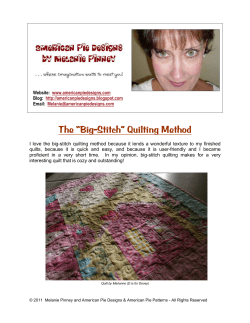
Running Stitch: Basting Page 1 15.105
Running Stitch: Basting 15.105 Page 1 Hand Basting Hand basting is a basic sewing skill that is easy to master with a little practice. In a world where faster is often considered better, the practice of hand sewing often gets overlooked, even though it is one of the easiest ways to perfect and simplify the rest of the sewing process. By taking the time to hand baste, you save time later, ultimately sewing quicker and more efficiently. Basting is a series of straight stitches executed by hand or machine to temporarily hold two or more layers of fabric together, or to mark a stitching line. Hand basting is used when pinning is awkward and better control is needed to hold the fabric layers together, such as around sharp corners, curved seams, small or tight areas or when the seam requires precise matching, as in striped or plaid fabrics. The running stitch, saddle stitch, and even and uneven basting are covered here. More advanced forms of basting, diagonal and slip basting, are covered in Guideline 15.240. Types of Hand Basting Most hand basting is a variation of a simple, straight running stitch that is secured with a knot or a backstitch at the beginning of the seam. If you knot the thread, remember to cut away the knot before you remove the stitches, so you don’t damage your fabric by pulling the knot through. If you use a backstitch to secure the thread (see Guideline 15.120), clip the backstitch before pulling out the basting. Running Stitch The running stitch is the simplest, quickest and most basic of all the hand stitches and is used to ease, gather, mend, baste and sew seams that are not subject to strain. It’s used for basting because the stitches are easy to remove after they’re no longer needed. Running stitches are easy to execute because they are a straight line of in-and-out stitches. The running stitch is a series of short, even stitches with short, even spaces between Tips for Hand Stitching • Hold your work on a flat, smooth surface. • Use scissors to cut the thread at a slight angle to make a clean cut, so it’s easier to thread through the needle’s eye. • Cut thread between 18" to 23" (45 cm to 60 cm) long, so it won’t tangle. Use a single strand of thread. • Coat the thread with beeswax if tangling is a problem and/or to make the thread stronger. • Silk and polyester threads are good choices for temporary basting because they won’t leave an impression after pressing. • Choose a thread color that contrasts with the fabric color for easier visibility. • If the thread twists while stitching, let the needle dangle and the thread will untwist. • When working with heavy fabric, wear a thimble on your index or middle finger to help push the needle through. • As you stitch, keep the thread taut, but don’t pull the stitches too tight. • Use a sharp, long needle for the long stitches used in basting. • Shorten the stitches when you need extra control for sharp corners or curves. Running Stitch: Basting 15.105 Page 2 them. Shorter stitches, 1/8" (3 mm) to 1/4" (6 mm) give the most control and are used for easing, gathering and seaming. Larger stitches, 1/2" (1.3 cm) to 3/4" (2 cm) are used for simple basting. Pull the needle and thread through the stitches and repeat. Uneven Basting Thread the needle and knot the thread, or secure the beginning of the stitching with a backstitch. A less precise hand stitch, uneven basting is used to mark fabric or to temporarily hold fabric layers that do not require close control, such as along straight seams. Working from right to left (if you’re left-handed, work from left to right), push the needle from the back side up through to the front. Take several 1/4" (6 mm) stitches onto the needle, but leave about 1" (2.5 cm) between the stitches (3). Begin by weaving the point of needle in and out of the fabric, catching all fabric layers, two or three times along the stitching line; then pull the needle and thread through the fabric. For basting, stitches should be about 1/2" (1.3 cm) to 3/4" (2 cm) long with the same length between each stitch. Continue in the same manner, taking two to three stitches at a time (1). 3 Saddle Stitch The saddle stitch is a decorative variation of the running stitch. It’s used for hand topstitching and to accent garment edges. Use heavier thread, such as buttonhole twist or embroidery thread, so the stitches stand out. 1 Keep the thread taut but not so tight that the fabric bunches. Backstitch and bring the needle and thread to the right side. Take a 1/4" (6 mm) to 3/8" (10 mm) stitch through all fabric layers the desired distance from the garment edge. Make sure the space between the stitches is the same length as the stitches (4). Even Basting This variation of the running stitch is quick, easy and strong. It’s frequently used on areas that need more security or control, such as curved seams. Take several 1/4" (6 mm) stitches onto the needle, keeping 1/4" (6 mm) spaces between each stitch (2). 4 Keep all stitches and spaces at least 1/4" (6 mm) long. 2 3/06
© Copyright 2025









